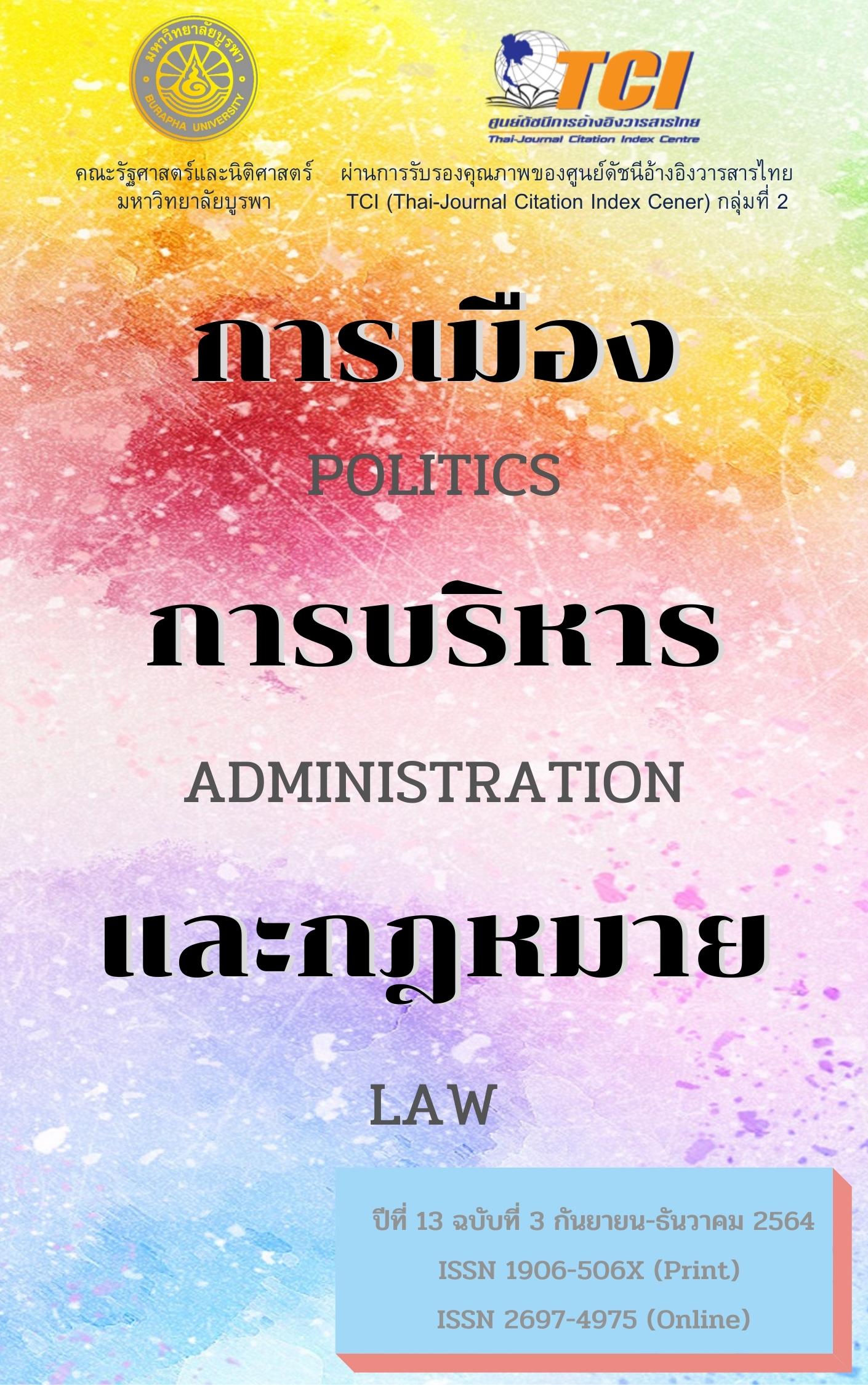ความพึงพอใจและความภักดีในฐานะตัวแปรคั่นกลางที่เชื่อมโยงระหว่างส่วนประสมทางการตลาดสู่การตั้งใจใช้บริการแอพพลิเคชั่น GrabFood ของผู้ใช้บริการ ในเขตฝั่งธนบุรี กรุงเทพมหานคร
คำสำคัญ:
ส่วนประสมทางการตลาด 7P, ความพึงพอใจ, ความภักดีตราสินค้า, การตั้งใจใช้บริการ, แอพพลิเคชั่น GrabFoodบทคัดย่อ
การศึกษาครั้งนี้มีวัตถุประสงค์ 1) เพื่อศึกษาปัจจัยส่วนประสมทางการตลาด ปัจจัยความพึงพอใจ ปัจจัยความภักดีตราสินค้า และปัจจัยการตั้งใจใช้บริการแอพพลิเคชั่น GrabFood ของผู้ใช้บริการในเขตฝั่งธนบุรี กรุงเทพมหานคร 2) เพื่อศึกษาปัจจัยความพึงพอใจ และปัจจัยความภักดีตราสินค้า ในฐานะตัวแปรคั่นกลางที่เชื่อมโยงส่วนประสมทางการตลาดสู่การตั้งใจใช้บริการแอพพลิเคชั่น GrabFood ของผู้ใช้บริการ ในเขตฝั่งธนบุรี กรุงเทพมหานคร เครื่องมือที่ใช้ในการวิจัยครั้งนี้คือ แบบสอบถาม โดยทำการเก็บข้อมูลกับผู้เลือกใช้บริการ GrabFood ในเขตฝั่งธนบุรี กรุงเทพมหานคร จำนวน 500 คน ตามแนวคิดของ Comrey and Lee (2013) สถิติที่ใช้ในการวิจัยประกอบด้วย (1) สถิติเชิงพรรณนา ได้แก่ค่าเฉลี่ย และ (2) สถิติการวิเคราะห์ตัวแบบสมการโครงสร้าง (SEM) โดยใช้โปรแกรม PLS Graph 3.0 ผลการวิจัยพบว่า ผู้ตอบแบบสอบถามส่วนใหญ่เป็นเพศหญิง อายุ 20-30 ปี มีสถานะสมรส รายได้น้อยกว่า 30,000 บาท ความถี่ในการใช้บริการในรอบเดือนที่ผ่านมาอยู่ที่ 2-5 ครั้ง โดยเลือกใช้บริการจากโปรโมชั่นนิยมใช้บริการในการสั่งอาหารไทยมาส่งอาหารที่บ้านหรือคอนโด ผลการทดสอบสมมติฐานพบว่า ส่วนประสมทางการตลาดมีอิทธิพลต่อความพึงพอใจ, ความภักดีตราสินค้า และการตั้งใจใช้บริการแอพพลิเคชั่น GrabFood ของผู้ใช้บริการ ในเขตฝั่งธนบุรี กรุงเทพมหานคร อย่างมีนัยสำคัญทางสถิติที่ระดับ 0.01 ความพึงพอใจและความภักดีตราสินค้ามีอิทธิพลต่อการตั้งใจใช้บริการแอพพลิเคชั่น GrabFood ของผู้ใช้บริการ ในเขตฝั่งธนบุรี กรุงเทพมหานคร อย่างมีนัยสำคัญทางสถิติที่ระดับ 0.01 อิทธิพลทางอ้อมของปัจจัยความพึงพอใจและความภักดีตราสินค้าเชื่อมโยงส่วนประสมทางการตลาดสู่การตั้งใจใช้บริการแอพพลิเคชั่น GrabFood ของผู้ใช้บริการ ในเขตฝั่งธนบุรี กรุงเทพมหานคร มีอิทธิทางอ้อมไม่เท่ากับ 0
เอกสารอ้างอิง
พิรานันท์ แกล่งกล้า. (2562). การวิเคราะห์คุณลักษณะของบริการแอพพลิเคชั่นเพื่อการสั่งอาหารเดลิเวอรี่ ในกรุงเทพมหานคร. การศึกษาค้นคว้าอิสระ, ธุรกิจการเกษตร. มหาวิทยาลัยเกษตรศาสตร์.
วรันธร ปรุงเรณู. (2558). ความพึงพอใจของครูที่มีต่อบริการงานธุรการของวิทยาลัยอาชีวศึกษาเทคนิคบริหารธุรกิจกรุงเทพ. วิจัยสถาบัน, การบริหารการศึกษามหาบัณฑิต. วิทยาลัยอาชีวศึกษาเทคนิคบริหารธุรกิจกรุงเทพ.
ศูนย์วิจัยกสิกรไทย. (2562). อยากกินต้องได้กิน SME ร้านอาหารปรับรับ Food Delivery. วันที่ค้นข้อมูล 5 พฤษภาคม 2564, เข้าถึงได้จาก https://kasikornresearch.com/SiteCollectionDocuments/ analysis/k-socialmedia/sme/ food%20Delivery/FoodDelivery.pdf
ศูนย์วิจัยกสิกรไทย. (2562). Food Delivery Application ดันธุรกิจ Food Delivery โตต่อเนื่อง. วันที่ค้นข้อมูล 5 พฤษภาคม 2564, เข้าถึงได้จาก https://kasikornresearch.com/th/analysis/k-social-media
Akani, G. H. (2020). Service Delivery Strategic and Customers’ Loyalty to Online Retailers in Rivers State. Journal of contemporary marketing, 5(1), 57-66
Andrian, Gunawan. (2015). The Role of Service Marketing Elements on Customer Loyalty towards Garuda Indonesia. Journal: iBuss Management, 3(2), 365-373.
Archarworarit W. (2015). The Study of Consumer Behavior and Selection Criteria on Alternative Taxi Service in Bangkok. Independent Study. Faculty of Commerce and Accountancy, Thammasat University.
Bloomer, & et al. (1999). Linking Perceived Service Quality and Service Loyalty: A Multi-dimensional Perspective. European Journal of Marketing, 33(11/12), 1082-1106.
Cengiz, E. (2010). Measuring Customer Satisfaction: Must or Not?. Journal of Naval Science and Engineering, 6(2), 76-88.
Comrey, A. L., & Lee, H. B. (1992). A first course in factor analysis. Hillsdale, NJ: Lawrence Erlbaum Associates.
Espejel, & et al. (2008). The Influence of Consumer Degree of Knowledge on Consumer Behavior: The Case of Spanish Olive Oil. Journal of Food Products Marketing, 15(1), 15-37.
Feras, M. I., Alnaser & et al., (2017). The Influence of Services Marketing Mix (7 Ps.) and Subjective Norms on Customer’s Satisfaction in Islamic Banks of Palestine. Journal: European of Business and Management, 9(27), 20-25.
Gerpott, T. J., Rams, W., & Schindler, A. (2001). Customer retention, loyalty, and satisfaction in the German mobile cellular telecommunications market. Telecommunications Policy, 25(4), 249-269.
Grab. (2019). GrabFood celebrates 4 million orders in first 4 months of 2019. Retrieved March 25, 2020, from https://www.grab.com/th/en/press/business/
Guo, L., Xiao, J. J., & Tang, C. (2009). Understanding the Psychological Process Underlying Customer Satisfaction and Retention in a Relational Service. Journal of Business Research, 62(11), 1152-1159.
Haruna, I. M. (2015). 7Ps Marketing Mix and Retail Bank Customer Satisfaction in Northeast Nigeria. British Journal of Marketing Studies, 3(3), 71-88.
Hauser, J. R., Semester, D. I., & Wernerfelt, B, (1994). Customer Satisfaction Incentives. Marketing Science, 13(4), 327–350.
Hellier, P. K., Geursen, G. M., Carr, R. A., & Rickard, J. A. (2003). Customer repurchase intention: a generalstructural equation model. European journal of marketing, 37(11/12), 1762-1800.
Inamullah, k. (2012). “mpact of Customers Satisfaction and Customers Retention on Customer Loyalty. International Journal of Scientific & Technology Research, 1(2), 106-110.
Lin, J. S. C., & Wu, C. Y., (2011). The role of expected future use in relationship-based service retention. Managing Service Quality, 21(5), 535-551.
Millet, J. D. (1954). Management in the Publics Service: The Quest for Effective Performance. New York: Mcgraw-Hill Book Company Inc.
Mohammad, M., Mehmood, B. & Shahzad, K. (2012). Attaining Customer Loyalty! The Role of Consumer Attitude and Consumer Behavior. Journal RMBR, 1(1), 1-8.
Moslehpour, M., Wong, W. K., Lin, Y. H., & Le Huyen, N. T., (2017). Top purchase intention priorities of Vietnamese LCC passengers: Expectations and satisfaction. Eurasian Business Review, forthcoming.
Nak, G. (2011). Student Loyalty toward Master’s Degree Business Administration Curriculum at Srinakharinwirot University. Journal Srinakharinwirot Business Administration, 2(1), 16-28.
Nasif, C. (2016). Influence of Electronic Word 0f Mouth on Consumer Purchase Intention. Thesis, Master of Supply Chain Management, University of Bangladesh.
Rezwan, M., & Sarif M. K. (2014). Impact of Service Marketing Mixes on Customer Perception: A Study on Eastern Bank Limited, Bangladesh. European Journal of Business and Management, 6(34), 164-173.
Richard, C., & Dubihlela, D. (2014). Does Customer Satisfaction Lead to Customer Trust, Loyalty and Repurchase Intention of Local Store Brands? The Case of Gauteng Province of South Africa. Journal. MCSER Publishing, 5(9), 23-32.
Rust, R. T., & Zahorik, A. J. (1993). Customer Satisfaction, Customer Retention and Market Share. Journal of retailing, 69(2), 193-215. Whitlark,
D. B., Geurts, M. D., & Swenson, M. J. (1993). New Product Forecasting with a Purchase Intention Survey. Journal of Business Forecasting, 12(3), 18-21.
Yaty, Sulaiman & Maha Mohammed Yusr & Khairull Anuar Ismail. (2017). The Influence of Marketing Mix and Perceived Risk Factors on Online Purchase Intentions. International Journal of Research in Business Studies and Management, 4(9), 30 – 40.
Zeithaml, V. A., Berry, L. L., & Parasuraman, A. (1996). The behavioral consequences of service quality. Journal of Marketing, 60(2), 31-46.
Zhang, et al. (2011). Application of simultaneous saccharification and fermentation (SSF) from viscosity reducing of raw sweet potato for bioethanol production at laboratory, pilot and industrial scales. Bioresour Technol, 102(6), 4573-4579.
ดาวน์โหลด
เผยแพร่แล้ว
ฉบับ
ประเภทบทความ
สัญญาอนุญาต

อนุญาตภายใต้เงื่อนไข Creative Commons Attribution-NonCommercial-NoDerivatives 4.0 International License.






